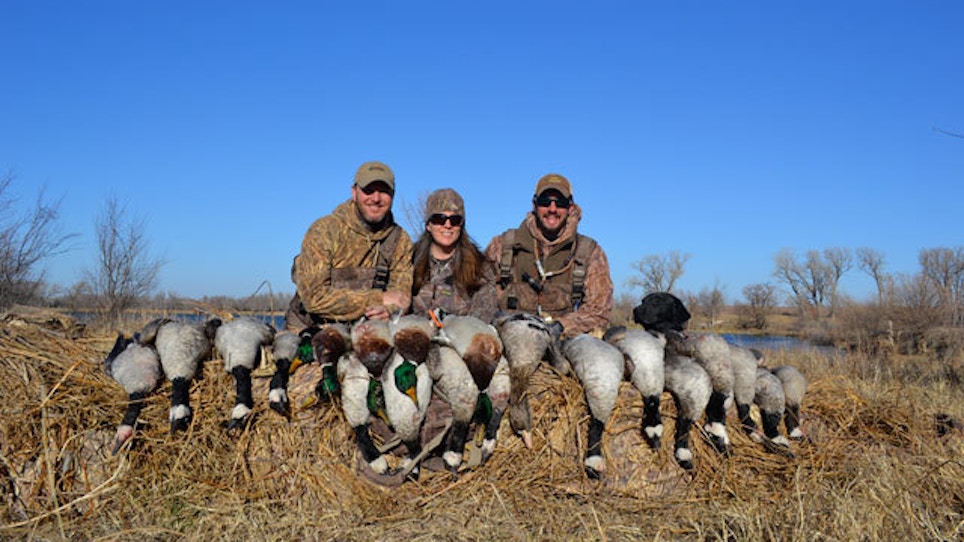I know how to hunt geese, or at least I thought I did.
Step One: Get up three hours before sunset, at a time so early you wonder if you'd have been better off not even going to bed at all the night before.
Step Two: Drive 45 minutes to "The X" with the heater off in the truck, chugging coffee and scarfing down a stale doughnut.
Step Three: Spend upwards of an hour hauling stuff out of the truck, brushing blinds and setting a couple hundred decoys out in the field.
Step Four: Nap in the blind until legal shooting time.
Step Five if you're lucky: Shoot a bunch of geese.
Step Five if you're not lucky: Watch flock after flock hit the neighboring field until someone makes the call to either move or quit.
I know all this. Been there, done that; sometimes in pits, but usually in layout blinds. So over dinner my first night in central Kansas with Avery pro-staffers Zach Simon and Derek Rambo, before we headed back to a hole-in-the-wall motel that seemed built just for hunters, I asked what time I should be ready to go in the morning — 4:30? 5?
"'Bout 6:30," Rambo said. "That'll give us time to grab breakfast."
They're kidding me, I thought. The sun rises at 7:30. We'll never make it.
But they weren't kidding, and the next morning I found myself at a local McDonald's at 6:45 in the morning, drinking coffee and watching the darkness fade. Not long after we parked the truck in a field with a view of where the birds were feeding. "Those geese'll get up before long, and then we'll head to where we'll set up," Zach said. "Want a doughnut?"
So over doughnuts (fresh, actually) and coffee we watched the geese take off, and then the work began. Out came the layout blinds and the decoys, and we hauled them in trips down to ... a lake. A lake? We're hunting geese on a lake?
"They'll be here in an hour or two to loaf," Zach explained, "and we'll just shoot 'em over the water." Fair enough. This guy shoots geese for a living, so I'll take his word for it.
We set blinds up on the bank and starting throwing out floating decoys — ducks and Canadas. Before long we'd settled into the layout blinds to wait. It was broad daylight, and it was chilly but not bone-chilling, 4-in-the-morning cold.
And the birds came. In small groups, in big groups, singles, doubles, Canada geese, mallards, a few specks. They wanted to be on the lake, and more specifically, they wanted to be right in front of that bank. It was on-the-X, in-your-face hunting at its finest. We even shot a few ducks while half of our party was walking around outside the blinds.
Kansas Lessers Over Water
With abundant corn, milo and wheat fields, the nearby Quivira NWR and Cheyenne Bottoms NWR, and plenty of water and feed to hold waterfowl in the heart of the Central Flyway, central Kansas is a hotbed of waterfowl activity. It's an ideal spot to try something you might not get to do on your home turf — like hunting lessers over water.
Regardless of where you're at, if you'd like to set up for geese over water, there are a few things you need to know.
"Hunting geese over water has several advantages," says Rambo. "Smaller spreads, usually better spots to hide, and you don't have to go early as the birds are returning from feeding in fields to the loafing water — generally from 9 a.m. to 1 p.m."
The trick, as usual, is finding out where the birds are going to be. "Find the mid-day or loafing water they are using," says Rambo, "not the overnight or roosting water to hunt, and you will have many options to hunt geese (field and water) for several days or until the birds move out. Hunting loafing ponds does not 'burn up' the roosting ponds."
So do your scouting a day ahead, then sleep in the next morning. Not a bad way to hunt, trust me.
As for decoys, you want floaters in the water with small resting and sleeping "pods" of decoys on the shoreline. There isn't usually a lot of feeding on a shoreline, so stay away from feeders — they won't look realistic. On our hunt, we mixed in a few GHG duck floaters on the water for realism.
When setting up blinds on the bank, your ideal scenario is a crossing shot that will take the birds' eyes off the blinds and onto the decoys — never with them approaching looking through the decoys to the blinds. Don't slack off on camouflaging your blinds; the birds probably use these ponds a lot and they'll know what looks right and what doesn't. Use the sun to your advantage if you can. "If you can have the birds approaching looking into the sun, it will help &'cover up' blinds as the birds will not be able to see as well. If it's cloudy, they can see better," Rambo advises.
Finally, he says, "If you're on the right loafing pond, they will come. Don't do much calling. Let the decoys do the work!"






